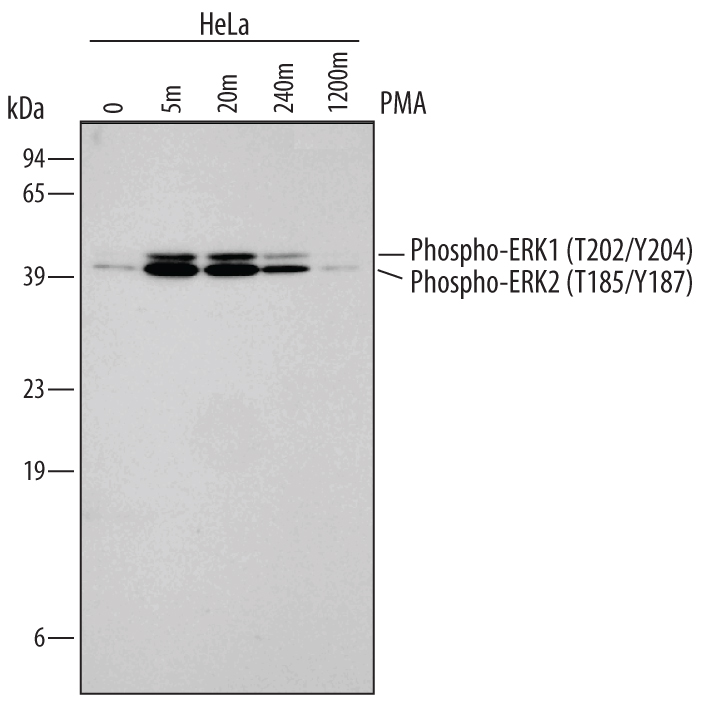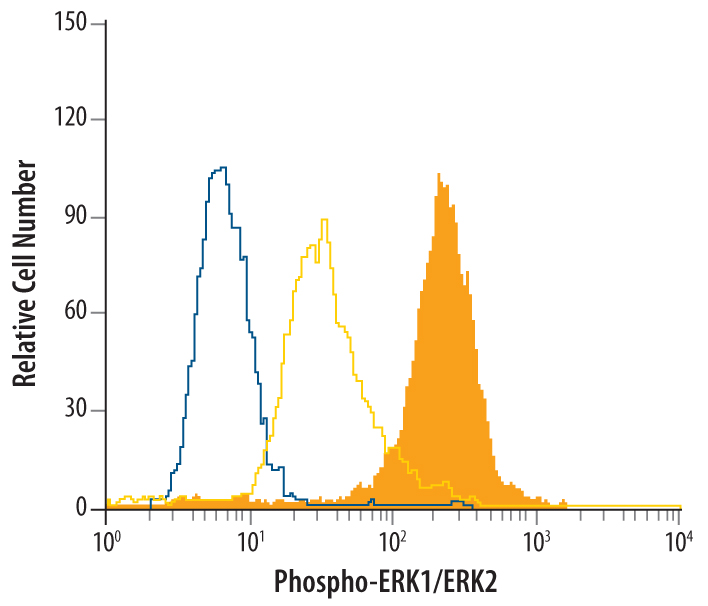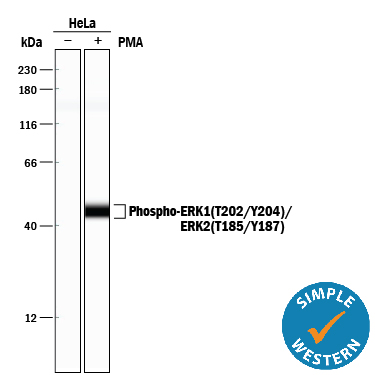Human/Mouse/Rat Phospho-ERK1(T202/Y204)/ERK2 (T185/Y187) Antibody Summary
*Small pack size (-SP) is supplied either lyophilized or as a 0.2 µm filtered solution in PBS.
Applications
Please Note: Optimal dilutions should be determined by each laboratory for each application. General Protocols are available in the Technical Information section on our website.
Scientific Data
 View Larger
View Larger
Detection of Human Phospho-ERK1 (T202/Y204) and ERK2 (T185/Y187) by Western Blot. Western blot shows lysates of HeLa human cervical epithelial carcinoma cell line untreated (-) or treated (+) with 200 nM PMA for for the indicated times. PVDF membrane was probed with 0.1 µg/mL of Rabbit Anti-Human/Mouse/Rat Phospho-ERK1 (T202/Y204)/ERK2 (T185/Y187) Antigen Affinity-purified Polyclonal Antibody (Catalog # AF1018), followed by HRP-conjugated Anti-Rabbit IgG Secondary Antibody (Catalog # HAF008). Specific bands were detected for Phospho-ERK1 (T202/Y204) and ERK2 (T185/Y187) at approximately 42 and 44 kDa (as indicated). This experiment was conducted under reducing conditions and using Immunoblot Buffer Group 1.
 View Larger
View Larger
Detection of Phospho-ERK1/ERK2 in Jurkat Human Cell Line by Flow Cytometry. Jurkat human acute T cell leukemia cell line were untreated (yellow line open histogram) or treated with 200 ng/mL PMA for 15 minutes (filled histogram) and stained with Rabbit Anti-Human/Mouse/Rat Phospho-ERK1/ERK2 (ERK1 T202/Y204, ERK2 T185/Y187) Antigen Affinity-purified Polyclonal Antibody (Catalog # AF1018) or control antibody (Catalog # AB-105-C, blue line open histogram), followed by Fluorescein-conjugated Anti-Rabbit IgG Secondary Antibody (Catalog # F0112). To facilitate intracellular staining, cells were fixed with PFA and permeabilized with ice-cold methanol.
 View Larger
View Larger
ERK1/ERK2 in Rat Brain. ERK1/ERK2 was detected in perfusion fixed frozen sections of rat brain (cortex) using 15 µg/mL Rabbit Anti-Human/Mouse/Rat Phospho-ERK1/ERK2 (ERK1 T202/Y204, ERK2 T185/Y187) Antigen Affinity-purified Polyclonal Antibody (Catalog # AF1018) overnight at 4 °C. Tissue was stained with the Anti-Rabbit HRP-DAB Cell & Tissue Staining Kit (brown; Catalog # CTS005) and counterstained with hematoxylin (blue). View our protocol for Chromogenic IHC Staining of Frozen Tissue Sections.
 View Larger
View Larger
Detection of Human Phospho-ERK1 (T202/Y204)/ERK2 (T185/Y187) by Simple WesternTM. Simple Western lane view shows lysates of HeLa human cervical epithelial carcinoma cell line untreated (-) or treated (+) with PMA, loaded at 0.2 mg/mL. A specific band was detected for ERK1 (T202/Y204)/ERK2 (T185/Y187) at approximately 44 kDa (as indicated) using 5 µg/mL of Rabbit Anti-Human/Mouse/Rat Phospho-ERK1 (T202/Y204)/ERK2 (T185/Y187) Antigen Affinity-purified Polyclonal Antibody (Catalog # AF1018). This experiment was conducted under reducing conditions and using the 12-230 kDa separation system.
Reconstitution Calculator
Preparation and Storage
- 12 months from date of receipt, -20 to -70 °C as supplied.
- 1 month, 2 to 8 °C under sterile conditions after reconstitution.
- 6 months, -20 to -70 °C under sterile conditions after reconstitution.
Background: ERK1/ERK2
ERK1 is a protein Serine/Threonine kinase that is a member of the extracellular signal-regulated kinases (ERKs) which are activated in response to numerous growth factors and cytokines (1). Activation of ERK1 requires both tyrosine and threonine phosphorylation that is mediated by MEK. ERK1 is ubiquitously distributed in tissues with the highest expression in heart, brain, and spinal cord. Activated ERK1 translocates into the nucleus where it phosphorylates various transcription factors.
Product Datasheets
Citations for Human/Mouse/Rat Phospho-ERK1(T202/Y204)/ERK2 (T185/Y187) Antibody
R&D Systems personnel manually curate a database that contains references using R&D Systems products. The data collected includes not only links to publications in PubMed, but also provides information about sample types, species, and experimental conditions.
41
Citations: Showing 1 - 10
Filter your results:
Filter by:
-
Kappa opioid receptor in nucleus accumbens regulates depressive-like behaviors following prolonged morphine withdrawal in mice
Authors: Jinyu Zhang, Ye Lu, Min Jia, Yuying Bai, Lulu Sun, Ziqing Dong et al.
iScience
-
SENP3-mediated deSUMOylation of c-Jun facilitates microglia-induced neuroinflammation after cerebral ischemia and reperfusion injury
Authors: Qian Xia, Meng Mao, Gaofeng Zhan, Zhenzhao Luo, Yin Zhao, Xing Li
iScience
-
Crosstalk between protein kinases AKT and ERK1/2 in human lung tumor-derived cell models
Authors: Aurimas Stulpinas, Matas Sereika, Aida Vitkeviciene, Ausra Imbrasaite, Natalija Krestnikova, Audrone V. Kalvelyte
Frontiers in Oncology
-
Dose-Dependent Biphasic Action of Quetiapine on AMPK Signalling via 5-HT7 Receptor: Exploring Pathophysiology of Clinical and Adverse Effects of Quetiapine
Authors: M Okada, K Fukuyama, E Motomura
International Journal of Molecular Sciences, 2022-08-14;23(16):.
Species: Rat
Sample Types: Cell Lysates
Applications: Simple Western -
Brexpiprazole Reduces 5-HT7 Receptor Function on Astroglial Transmission Systems
Authors: K Fukuyama, E Motomura, M Okada
International Journal of Molecular Sciences, 2022-06-12;23(12):.
Species: Rat
Sample Types: Cell Lysates
Applications: Simple Western -
High Mobility Group A 1 Expression as a Poor Prognostic Marker Associated with Tumor Invasiveness in Gastric Cancer
Authors: Hung-Pin Chang, Jen-Tang Sun, Chiao-Yin Cheng, Yao-Jen Liang, Yen-Lin Chen
Life (Basel)
-
The potential of organoids in toxicologic pathology: Histopathological and immunohistochemical evaluation of a mouse normal tissue-derived organoid-based carcinogenesis model
Authors: Rikako Ishigamori, Mie Naruse, Akihiro Hirata, Yoshiaki Maru, Yoshitaka Hippo, Toshio Imai
Journal of Toxicologic Pathology
-
O-GlcNAcylation Is Essential for Rapid Pomc Expression and Cell Proliferation in Corticotropic Tumor Cells
Authors: Massman LJ, Pereckas M, Zwagerman NT, Olivier-Van Stichelen S.
Endocrinology
-
Distinct Effects of Escitalopram and Vortioxetine on Astroglial L-Glutamate Release Associated with Connexin43
Authors: T Shiroyama, K Fukuyama, M Okada
International Journal of Molecular Sciences, 2021-09-16;22(18):.
Species: Rat
Sample Types: Cell Lysates
Applications: Simple Western -
Different properties of mammary carcinogenesis induced by two chemical carcinogens, DMBA and PhIP, in heterozygous BALB/c Trp53 knockout mice
Authors: Y Machida, T Imai
Oncology Letters, 2021-08-16;22(4):738.
Species: Mouse
Sample Types: Whole Tissue
Applications: IHC -
The miR-106b/NR2F2-AS1/PLEKHO2 Axis Regulates Migration and Invasion of Colorectal Cancer through the MAPK Pathway
Authors: Shuzhen Liu, Guoyan An, Qing Cao, Tong Li, Xinyu Jia, Lei Lei
International Journal of Molecular Sciences
-
Regulation of CREB Phosphorylation in Nucleus Accumbens after Relief Conditioning
Authors: E Soleimanpo, JR Bergado Ac, P Landgraf, D Mayer, E Dankert, DC Dieterich, M Fendt
Cells, 2021-01-26;10(2):.
Species: Rat
Sample Types: Tissue Homogenates
Applications: Western Blot -
IL-24 deficiency protects mice against bleomycin-induced pulmonary fibrosis by repressing IL-4-induced M2 program in macrophages
Authors: LZ Rao, Y Wang, L Zhang, G Wu, L Zhang, FX Wang, LM Chen, F Sun, S Jia, S Zhang, Q Yu, JH Wei, HR Lei, T Yuan, J Li, X Huang, B Cheng, J Zhao, Y Xu, BW Mo, CY Wang, H Zhang
Cell Death Differ, 2020-11-03;0(0):.
Species: Mouse
Sample Types: Whole Tissue
Applications: IHC -
Age-Dependent and Sleep/Seizure-Induced Pathomechanisms of Autosomal Dominant Sleep-Related Hypermotor Epilepsy
Authors: Fukuyama K, Okada M.
International Journal of Molecular Sciences
-
Protective effect of puerarin against burn‑induced heart injury in rats
Authors: Junling Liu, Jianyun Liu, Mingming Bai, Hui Wang
Experimental and Therapeutic Medicine
-
Increased Release of Proinflammatory Proteins in Primary Human Adipocytes and Activation of the Inflammatory NF?B, p38, and ERK Pathways upon Omentin Treatment
Authors: C Niersmann, K Röhrig, M Blüher, M Roden, C Herder, M Carstensen
Obes Facts, 2020-04-06;13(2):221-236.
Species: Human
Sample Types: Cell Lysates
Applications: Western Blot -
Immunodeficiency in a Patient with 22q11.2 Distal Deletion Syndrome and a p.Ala7dup Variant in the MAPK1 Gene
Authors: Ana I. Sánchez, Mary A. García-Acero, Angela Paredes, Rossi Quero, Rita I. Ortega, Jorge A. Rojas et al.
Molecular Syndromology
-
Fluid supplementation accelerates epithelial repair during chemical colitis
Authors: JF Burgueño, JK Lang, AM Santander, I Fernández, E Fernández, J Zaias, MT Abreu
PLoS ONE, 2019-04-19;14(4):e0215387.
Species: Mouse
Sample Types: Whole Tissue
Applications: IHC-P -
mTOR-dependent phosphorylation controls TFEB nuclear export
Authors: Gennaro Napolitano, Alessandra Esposito, Heejun Choi, Maria Matarese, Valerio Benedetti, Chiara Di Malta et al.
Nature Communications
-
Characterization of TRKA signaling in acute myeloid leukemia
Authors: SM Herbrich, S Kannan, RM Nolo, M Hornbaker, J Chandra, PA Zweidler-M
Oncotarget, 2018-07-10;9(53):30092-30105.
Species: Human
Sample Types: Cell Lysates
Applications: Western Blot -
PI(4,5)P2 determines the threshold of mechanical force-induced B cell activation
Authors: Z Wan, C Xu, X Chen, H Xie, Z Li, J Wang, X Ji, H Chen, Q Ji, S Shaheen, Y Xu, F Wang, Z Tang, JS Zheng, W Chen, J Lou, W Liu
J. Cell Biol., 2018-04-23;0(0):.
Species: Mouse
Sample Types: Whole Cells
Applications: ICC -
Ferric citrate and ferric EDTA but not ferrous sulfate drive amphiregulin-mediated activation of the MAP kinase ERK in gut epithelial cancer cells
Authors: NM Scheers, DIA Pereira, N Faria, JJ Powell
Oncotarget, 2018-03-30;9(24):17066-17077.
Species: Human
Sample Types: Cell Lysates
Applications: Western Blot -
Glycans modify mesenchymal stem cell differentiation to impact the function of resulting osteoblasts
Authors: KM Wilson, AM Jagger, M Walker, E Seinkmane, JM Fox, R Kröger, P Genever, D Ungar
J. Cell. Sci., 2018-02-14;0(0):.
Species: Human
Sample Types: Cell Lysates
Applications: Western Blot -
Obesity Increases Mitogen-Activated Protein Kinase Phosphatase-3 Levels in the Hypothalamus of Mice
Authors: BA Rodrigues, VR Muñoz, GK Kuga, RC Gaspar, SCBR Nakandakar, BM Crisol, JD Botezelli, LSS Pauli, ASR da Silva, LP de Moura, DE Cintra, ER Ropelle, JR Pauli
Front Cell Neurosci, 2017-10-09;11(0):313.
Species: Mouse
Sample Types: Tissue Homogenates
Applications: Western Blot -
In vitro and in vivo anti-tumor activity of alectinib in tumor cells with NCOA4-RET
Authors: Sachiko Arai, Kenji Kita, Azusa Tanimoto, Shinji Takeuchi, Koji Fukuda, Hiroshi Sato et al.
Oncotarget
-
Use of non-selective ?-blockers is associated with decreased tumor proliferative indices in early stage breast cancer
Authors: A Montoya, CN Amaya, A Belmont, N Diab, R Trevino, G Villanueva, S Rains, LA Sanchez, N Badri, S Otoukesh, A Khammanivo, D Liss, ST Baca, RJ Aguilera, EB Dickerson, A Torabi, AK Dwivedi, A Abbas, K Chambers, BA Bryan, Z Nahleh
Oncotarget, 2017-01-24;8(4):6446-6460.
Species: Human
Sample Types: Cell Lysates
Applications: Western Blot -
Sirtuin 3 (SIRT3) Regulates ?-Smooth Muscle Actin (?-SMA) Production through the Succinate Dehydrogenase-G Protein-coupled Receptor 91 (GPR91) Pathway in Hepatic Stellate Cells
J Biol Chem, 2016-02-24;291(19):10277-92.
Species: Human
Sample Types: Cell Lysates
Applications: Western Blot -
Mycobacteria bypass mucosal NF-kB signalling to induce an epithelial anti-inflammatory IL-22 and IL-10 response.
Authors: Lutay N, Hakansson G, Alaridah N, Hallgren O, Westergren-Thorsson G, Godaly G
PLoS ONE, 2014-01-28;9(1):e86466.
Species: Human
Sample Types: Cell Lysates
Applications: Western Blot -
Ability of the Met kinase inhibitor crizotinib and new generation EGFR inhibitors to overcome resistance to EGFR inhibitors.
Authors: Nanjo, Shigeki, Yamada, Tadaaki, Nishihara, Hiroshi, Takeuchi, Shinji, Sano, Takako, Nakagawa, Takayuki, Ishikawa, Daisuke, Zhao, Lu, Ebi, Hiromich, Yasumoto, Kazuo, Matsumoto, Kunio, Yano, Seiji
PLoS ONE, 2013-12-26;8(12):e84700.
Species: Human
Sample Types: Cell Lysates
Applications: Western Blot -
Role of NADPH oxidase isoforms NOX1, NOX2 and NOX4 in myocardial ischemia/reperfusion injury
Authors: Vincent Braunersreuther, Fabrizio Montecucco, Mohamed Asrih, Mohammed Ashri, Graziano Pelli, Katia Galan et al.
Journal of Molecular and Cellular Cardiology
-
Influence of gefitinib and erlotinib on apoptosis and c-MYC expression in H23 lung cancer cells.
Authors: Suenaga M, Yamamoto M, Tabata S, Itakura S, Miyata M, Hamasaki S, Furukawa T
Anticancer Res, 2013-04-01;33(4):1547-54.
Species: Human
Sample Types: Cell Lysates
Applications: Western Blot -
Perlecan Domain V induces VEGF secretion in brain endothelial cells through integrin alpha5beta1 and ERK-dependent signaling pathways.
Authors: Clarke D, Al Ahmad A, Lee B, Parham C, Auckland L, Fertala A, Kahle M, Shaw C, Roberts J, Bix G
PLoS ONE, 2012-09-17;7(9):e45257.
Species: Human
Sample Types: Cell Lysates
Applications: Western Blot -
The EGFR ligands amphiregulin and heparin-binding egf-like growth factor promote peritoneal carcinomatosis in CXCR4-expressing gastric cancer.
Authors: Yasumoto K, Yamada T, Kawashima A, Wang W, Li Q, Donev IS, Tacheuchi S, Mouri H, Yamashita K, Ohtsubo K, Yano S
Clin. Cancer Res., 2011-04-11;17(11):3619-30.
Species: Human
Sample Types: Cell Lysates
Applications: Western Blot -
Transient PI3K Inhibition Induces Apoptosis and Overcomes HGF-Mediated Resistance to EGFR-TKIs in EGFR Mutant Lung Cancer.
Authors: Donev IS, Wang W, Yamada T, Li Q, Takeuchi S, Matsumoto K, Yamori T, Nishioka Y, Sone S, Yano S
Clin. Cancer Res., 2011-01-10;17(8):2260-9.
Species: Human
Sample Types: Cell Lysates
Applications: Western Blot -
PKCalpha-induced drug resistance in pancreatic cancer cells is associated with transforming growth factor-beta1
Authors: Ying Chen, Guanzhen Yu, Danghui Yu, Minghua Zhu
Journal of Experimental & Clinical Cancer Research
-
Deoxygedunin, a natural product with potent neurotrophic activity in mice.
Authors: Jang SW, Liu X, Chan CB
PLoS ONE, 2010-07-13;5(7):e11528.
Species: Mouse
Sample Types: Cell Lysates
Applications: Western Blot -
Long-term high glucose concentration influences Akt, ERK1/2, and PTP1B protein expression in human aortic smooth muscle cells.
Authors: Popov D, Nemecz M, Dumitrescu M, Georgescu A, Bohmer FD
Biochem. Biophys. Res. Commun., 2009-08-04;388(1):51-5.
Species: Human
Sample Types: Cell Lysates
Applications: Western Blot -
CB(2) cannabinoid receptor activation is cardioprotective in a mouse model of ischemia/reperfusion.
Authors: Montecucco F, Lenglet S, Braunersreuther V, Burger F, Pelli G, Bertolotto M, Mach F, Steffens S
J. Mol. Cell. Cardiol., 2009-01-07;46(5):612-20.
Species: Mouse
Sample Types: Tissue Homogenates
Applications: Western Blot -
E-selectin regulates gene expression in metastatic colorectal carcinoma cells and enhances HMGB1 release.
Authors: Aychek T, Miller K, Sagi-Assif O, Levy-Nissenbaum O, Israeli-Amit M, Pasmanik-Chor M, Jacob-Hirsch J, Amariglio N, Rechavi G, Witz IP
Int. J. Cancer, 2008-10-15;123(8):1741-50.
Species: Human
Sample Types: Cell Lysates
Applications: Western Blot -
The RAS/Raf1/MEK/ERK signaling pathway facilitates VSV-mediated oncolysis: implication for the defective interferon response in cancer cells.
Authors: Noser JA, Mael AA, Sakuma R, Ohmine S, Marcato P, Lee PW, Ikeda Y
Mol. Ther., 2007-05-15;15(8):1531-6.
Species: Human
Sample Types: Cell Lysates
Applications: Western Blot -
Autocrine role of angiopoietins during megakaryocytic differentiation.
Authors: Saulle Ernestina, Guerriero Raffaella, Petronelli Alessia et al.
PloS One
FAQs
No product specific FAQs exist for this product, however you may
View all Antibody FAQsReviews for Human/Mouse/Rat Phospho-ERK1(T202/Y204)/ERK2 (T185/Y187) Antibody
Average Rating: 5 (Based on 3 Reviews)
Have you used Human/Mouse/Rat Phospho-ERK1(T202/Y204)/ERK2 (T185/Y187) Antibody?
Submit a review and receive an Amazon gift card.
$25/€18/£15/$25CAN/¥75 Yuan/¥2500 Yen for a review with an image
$10/€7/£6/$10 CAD/¥70 Yuan/¥1110 Yen for a review without an image
Filter by:






















